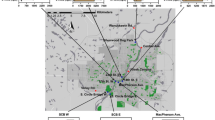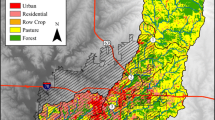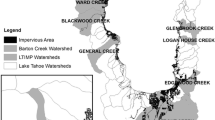Abstract
Stormwater management ponds have become a common Best Management Practice in urban and suburban landscapes. Stormwater management ponds are designed to hold runoff from impervious surfaces and allow the settling of sediments and associated pollutants. Various semi-aquatic and aquatic wildlife species have been documented using stormwater management ponds as habitat, but these wetland-like systems are not managed to adhere to freshwater habitat pollutant guidelines. To address the potential for pollutant exposure for wildlife, we used a random sample of 68 stormwater ponds and estimated the proportion of ponds in a third-order watershed that exceed toxicity guidelines for trace metals and polycyclic aromatic hydrocarbons in sediments and chloride in surface waters. Ninety-six percent of ponds exceeded consensus-based threshold effect concentrations for at least one trace metal. Concentrations of at least one of the PAHs measured exceeded the threshold effects concentration in 63% of the ponds. Nine percent of ponds exceeded chronic toxicity levels of chloride on all sampling dates, and 21% exceeded acute toxicity concentrations on at least one sampling date. More studies are needed to evaluate toxic effects of pollutants in stormwater management ponds and the potential for interactive effects of pollutants on wildlife.




Similar content being viewed by others
References
Amrhein C, Strong JE, Mosher PA (1992) Effect of deicing salts on metal andorganic matter mobilization in roadside soils. Environ Sci Technol 26:703–709
Bingham FT, Sposito G, Strong JE (1984) The effect of chloride on the availability of cadmium. J Environ Qual 13:71–74
Bishop CA, Struger J, Barton DR, Shirose LJ, Dunn L, Lang AL, Shepherd D (2000a) Contamination and wildlife communities in stormwater detention ponds in Guelph and the Greater Toronto Area, Ontario, 1997 and 1998. Part I—Wildlife communities. Water Qual Res J Can 35:399–435
Bishop CA, Struger J, Shirose LJ, Dunn L, Campbell GD (2000b) Contamination and wildlife communities in stormwater detention ponds in Guelph and the Greater Toronto Area, Ontario, 1997 and 1998. Part II—Contamination and biological effects of contamination. Water Qual Res J Can 35:436–474
Brand AB (2008) Stormwater ponds in an urbanizing landscape: Landscape change and habitat value. M.S. Thesis, Towson University, Towson Maryland
Brand AB, Snodgrass JW (2010) The value of manmade habitats for amphibian reproduction in altered landscapes. Conserv Biol 24:195–301
Brand AB, Snodgrass JW, Gallagher MT, Casey CE, Van Meter R (2010) Lethal and sublethal effects of embryonic and larval exposure of Hyla versicolor to stormwater pond sediments. Arch Environ Contam Toxicol 58:325–331
Campbell KR (1994) Concentrations of heavy metals associated with urban runoff in fish living in stormwater treatment ponds. Arch Environ Contam Toxicol 27:352–356
Casey RE, Shaw AN, Massal LR, Snodgrass JW (2005) Multimedia evaluation of trace metal distribution within stormwater ponds in suburban Maryland, USA. B Environ Contam Toxicol 74:273–280
Casey RE, Simon JA, Atueyi S, Snodgrass JW, Karouna-Renier N, Sparling DW (2007) Temporal trends of trace metals in sediment and invertebrates from stormwater retention ponds. Water Air Soil Pollut 178:69–77
Collins SJ, Russel RW (2008) Toxicity of road salt to Nova Scotia amphibians. Environ Pollut 157:320–324
Doner HE (1978) Chloride as a factor in mobilities of Ni, Cu and Cd in soil. Soil Sci Soc Am J 42:882–885
Ehrenfeld JB (2000) Evaluating wetlands within an urban context. Ecol Eng 15:253–265
Environment Canada (2001) Canadian Environmental Protection Act, 1999, Priority Substances List Assessment Report—Road Salt, Hull, Quebec
EPA (2004) Assigning values to non-detected/non-quantified pesticide residues in human health food exposure assessments. US Environmental Protection Agency, Washington DC. Online at: http://www.epa.gov/pesticides/trac/science/trac3b012.pdf
EPA (2009) National recommended water quality criteria. US Environmental Protection Agency, Washington DC. Online at: http://www.epa.gov/waterscience/criteria/wqctable/
Haas CN, Scheff PA (1990) Estimation of averages in truncated samples. Environ Sci Technol 24:912–919
Harris LD (1988) Edge effects and conservation of biotic diversity. Conserv Biol 2:330–332
Helsel DR (1990) Less than obvious—statistical treatment of data below the detection limit. Environ Sci Technol 24:1766–1774
Jahnige, P (1999) The Gwynns Falls Watershed Ecological Resource Atlas. United States Forest Service. Baltimore, MD: Parks and People Foundation, Revitalizing Baltimore Project
Karouna-Renier NK, Sparling DW (1997) Toxicity of stormwater treatment pond sediments to Hyalella azteca (Amphipoda). B Environ Contam Toxicol 58:550–557
Karouna-Renier NK, Sparling DW (2001) Relationships between ambient geochemistry, watershed land-use and trace metal concentrations in aquatic invertebrates living in stormwater treatment ponds. Environ Pollut 112:183–192
Karraker NE (2008) Impacts of road deicing salts on amphibians and their habitats. In: Mitchell JC, Jung-Brown RE, Bartholomew B (eds) Urban Herpetology. Herpetological Conservation vol. 3. Society for the Study of Amphibians and Reptiles, Salt Lake City, pp
Karraker NE, Gibbs JP, Vonesh JR (2008) Impacts of road deicing salt on the demography of vernal pool-breeding amphibians. Ecol Appl 18:724–734
Liebens J (2001) Heavy metal contamination of sediments in stormwater management systems: the effect of land use, particle size, and age. Environ Geol 41:341–351
Macdonald DD, Ingersoll CG, Berger TA (2000) Development and evaluation of consensus-based sediment quality guidelines for freshwater ecosystems. Arch Environ Contam Toxicol 39:20–31
Marsalek J (2003) Road salts in urban stormwater: an emerging issue in stormwater management in cold climates. Water Sci Technol 48:61–70
McDaniel TV, Harris ML, Bishop CA, Struger J (2004) Development and survivorship of Northern Leopard Frogs (Rana pipiens) and Green Frogs (Rana clamitans) exposed to contaminants in the water and sediments of the St. Lawrence River near Cornwall, Ontario. Water Qual Res J Can 39:160–174
MDE (2007) Total maximum daily loads of fecal bacteria for the non-tidal Gwynns Falls Basin in Baltimore City and Baltimore County, Maryland. Baltimore, MD: Maryland Department of the Environment. Online at: http://www.mde.state.md.us/assets/document/GwynnsFalls_TMDL_092106_final.pdf
MDE (2010) Total maximum daily load of sediment in the Gwynns Falls watershed, Baltimore City and Baltimore County, Maryland. Baltimore, MD: Maryland Department of the Environment. Online at: http://www.mde.state.md.us/assets/document/Gwynns_Sed_TMDL_072610_Final.pdf
Morgan RP II, Kline KM, Cushman SF (2007) Relationships among nutrients, chloride, and biological indices in urban Maryland streams. Urban Ecosyst 10:153–166
Nightingale HI (1987) Accumulation of As, Ni, Cu, and Pb in retention and recharge basins soils from urban runoff. Water Resour Bull 23:663–668
Niyogi S, Wood CM (2004) Biotic ligand model, a flexible tool for developing site-specific water quality guidelines for metals. Environ Sci Technol 38:6177–6192
Norrstrom AC, Jacks G (1998) Concentration and fractionation of heavy metals in roadside soils receiving de-icing salts. Sci Total Environ 218:161–174
Paul MJ, Meyer JL (2001) Streams in the urban landscape. Annu Rev Ecol Syst 32:333–365
R Development Core Team (2009) R: A language and environment for statistical computing. R Foundation for Statistical Computing, Vienna, Austria. URL http://www.R-project.org
Ross TD (2003) Accurate confidence intervals for binomial proportion and Poisson rate estimation. Comput Biol Med 33:509–531
Scher O, Thiery A (2005) Odonata, Amphibia and environmental characteristics in motorway stormwater retention ponds (Southern France). Hydrobiologia 551:237–251
Simon JA, Snodgrass JW, Casey RE, Sparling DW (2009) Spatial correlates of amphibian use of constructed wetlands in an urban landscape. Landscape Ecol 24:361–373
Snodgrass JW, Casey RE, Joseph D, Simon JA (2008) Microcosm investigations of stormwater pond sediment toxicity to embryonic and larval amphibians: variation in sensitivity among species. Environ Pollut 154:291–297
Sparling DW, Eisemann JD, Kuenzel W (2004) Contaminant exposure and effects in red-winged blackbirds inhabiting stormwater retention ponds. Environ Manage 33:719–729
Travis CC, Land ML (1990) Estimating the mean of data sets with nondetectable values. Environ Sci Technol 24:961–962
Villareal EL, Semadeni-Davies A, Bengtsson L (2004) Inner city stormwater control using a combination of best management practices. Ecol Eng 22:279–298
Wiens JA (1976) Population responses to patchy environments. Annu Rev Ecol Syst 7:81–120
Wigington PJ, Randall CW, Grizzard TJ (1983) Accumulation of selected trace metals in soils of urban runoff detention basins. Water Resour Bull 19:709–718
Wilson EB (1927) Probable inference, the law of succession, and statistical inference. J Am Stat Assoc 22:209–212
Wren CD, Bishop CA, Stewart DL, Barrett GC (1997) Wildlife and contaminants in constructed wetlands and stormwater ponds: Current state of knowledge and protocols for monitoring contaminant levels and effects in wildlife. Canadian Wildlife Service Technical Report No. 269, Toronto
Acknowledgments
This research was funded by a USGS National Competitive Grant through the Water Resources Research institute at the University of Maryland (Project ID: 2007MD160G). The Baltimore County government supplied aerial photographs for pond identification.
Author information
Authors and Affiliations
Corresponding author
Rights and permissions
About this article
Cite this article
Gallagher, M.T., Snodgrass, J.W., Ownby, D.R. et al. Watershed-scale analysis of pollutant distributions in stormwater management ponds. Urban Ecosyst 14, 469–484 (2011). https://doi.org/10.1007/s11252-011-0162-y
Published:
Issue Date:
DOI: https://doi.org/10.1007/s11252-011-0162-y




